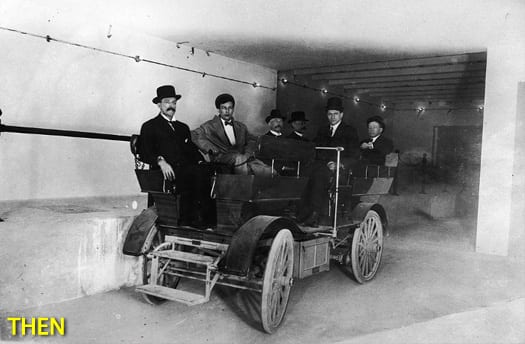 Old electric Senate subway wooden-wheel Studebaker car 1909
Old electric Senate subway wooden-wheel Studebaker car 1909 There is a secret subway in Washington DC
It’s true. Though it’s really more of a private subway system than secret one. The U.S. Capitol, as well as the massive House and Senate office buildings are all connected underground by Congress’ very own subway system. It started operating in 1909 (nearly 70 years before the rest of Washington got a subway system) and has been upgraded and expanded over the years. The subway is open to the public provided they are escorted by a staff member with proper identification. However, during votes, the House subway is restricted to Congressional members only. The Russell subway is restricted to members and staff only during times when the Senate is voting. You can read more about it here and here.
Perhaps some of these politicians who’ve been ragging on public transit don’t realize they’ve been riding on it all along. But look around, esteemed elected officials: Isn’t it just great when you don’t have to walk that fifth of a mile back to your office after casting a vote to cut transit funding? – from These Transit Riding Politicians Don’t Support Public Transit
Speaking of transit funding, late Wednesday evening the House and Senate finally reached a deal on the long awaited transportation bill. SAFETEA-LU* had been extended nine times previously and they cut it awfully close this time; without a long-term bill or another extension of previous law, U.S. authority to collect the 18.4-cents-a-gallon gasoline tax would run out June 30, cutting off money to states for programs funded by the U.S. Highway Trust Fund. Thousands of construction and government workers would probably be idled if that happened.
Representative John Mica, the chairman of the House Transportation and Infrastructure Committee, said the bill would cut red tape and attract more private financing for projects. The compromise measure would extend current levels of spending on highways, bridges and mass transit through the end of fiscal 2014. Both houses are now expected to vote on either Friday or Saturday in advance of the Fourth of July holiday.
The transportation bill conference report was released this morning. Read the entire report here (warning! It’s 599 pages long); a more condensed statement on it can be found here. (It’s a more reasonable 91 pages long.)
* For non-wonks, that’s Safe, Accountable, Flexible, Efficient Transportation Equity Act: A Legacy for Users which is a funding and authorization bill that governs United States federal surface transportation spending.
Here are some interesting additional links if you want to find out more:
- Transportation Bill Renewal Needed All Nine Lives
- Congress reaches deal on transportation bill, the first since 2005
- Congress Readies Transportation Plan With Focus on Roads
- Mica: Transpo Bill Lasts Through September 2014
- Boxer Confirms That Some Bike/Ped Protections Remain in Final Bill
- Complete Streets Provision Eliminated From Final Transpo Bill
- Transpo Bill Cuts Bike/Ped Funding, Lets States Spend It on Left-Turn Lanes
- Rails-to-Trails: Final Transpo Bill “Bad News for America” [Updated]
- House puts brakes on taxing cars by the mile
- Boxer calls highway bill compromise a ‘victory’
- GOP claiming victories in likely highway bill deal despite Keystone elimination
- Tentative Deal Reached on 2-Year Transportation Bill
(Monday – Friday SDOT sends out a compilation of local and national transportation news links. If you’d like to subscribe (or unsubscribe) to the list, just send an email to allie.gerlach@seattle.gov and I’ll take care of it for you. )

